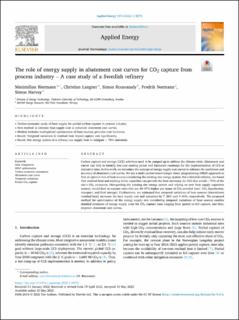| dc.contributor.author | Biermann, Maximilian | |
| dc.contributor.author | Langner, Christian | |
| dc.contributor.author | Roussanaly, Simon | |
| dc.contributor.author | Normann, Fredrik | |
| dc.contributor.author | Harvey, Simon | |
| dc.date.accessioned | 2022-07-21T07:27:51Z | |
| dc.date.available | 2022-07-21T07:27:51Z | |
| dc.date.created | 2022-05-25T08:51:08Z | |
| dc.date.issued | 2022 | |
| dc.identifier.issn | 0306-2619 | |
| dc.identifier.uri | https://hdl.handle.net/11250/3007441 | |
| dc.description.abstract | Carbon capture and storage (CCS) activities need to be ramped up to address the climate crisis. Abatement cost curves can help to identify low-cost starting points and formulate roadmaps for the implementation of CCS at industrial sites. In this work, we introduce the concept of energy supply cost curves to enhance the usefulness and accuracy of abatement cost curves. We use a multi-period mixed-integer linear programming (MILP) approach to find an optimal mix of heat sources considering the existing site energy system. For a Swedish refinery, we found that residual heat and existing boiler capacities can provide the heat necessary for CCS that avoids >75% of the site’s CO2 emissions. Disregarding the existing site energy system and relying on new heat supply capacities instead, would lead to capture costs that are 40–57% higher per tonne of CO2-avoided (excl. CO2 liquefaction, transport, and final storage). Furthermore, we estimated that temporal variations of heat sources (intermittent residual heat) increases the heat supply cost and emissions by 7–26% and 9–66%, respectively. The proposed method for optimization of the energy supply mix considering temporal variations of heat sources enables detailed estimates of energy supply costs for CO2 capture rates ranging from partial to full capture, and thus, improve abatement cost curves. | en_US |
| dc.description.abstract | The role of energy supply in abatement cost curves for CO2 capture from process industry – A case study of a Swedish refinery | en_US |
| dc.language.iso | eng | en_US |
| dc.publisher | Elsevier | en_US |
| dc.rights | Navngivelse 4.0 Internasjonal | * |
| dc.rights.uri | http://creativecommons.org/licenses/by/4.0/deed.no | * |
| dc.title | The role of energy supply in abatement cost curves for CO2 capture from process industry – A case study of a Swedish refinery | en_US |
| dc.title.alternative | The role of energy supply in abatement cost curves for CO2 capture from process industry – A case study of a Swedish refinery | en_US |
| dc.type | Peer reviewed | en_US |
| dc.type | Journal article | en_US |
| dc.description.version | publishedVersion | en_US |
| dc.rights.holder | The Authors | en_US |
| dc.source.volume | 319 | en_US |
| dc.source.journal | Applied Energy | en_US |
| dc.identifier.doi | 10.1016/j.apenergy.2022.119273 | |
| dc.identifier.cristin | 2027169 | |
| dc.source.articlenumber | 119273 | en_US |
| cristin.ispublished | true | |
| cristin.fulltext | original | |
| cristin.qualitycode | 1 | |

